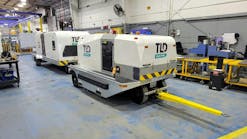Putting the Aesthetics into Ground Power Solutions
ITW GSE Americas Hobart knows power solutions. With their 2400 Power Coil, Hobart addressed and improved a number of key issues for GSE users.
First off, the 2400 Power Coil was designed as a 2-in-1 solution featuring a 400 Hz 90 kVA solid state frequency ground power unit and a cable reel in one housing—this solution represents a radical improvement in the ground support industry.
The Hobart 2400 Power Coil is designed to operate well with all sizes of bridges and aircraft models. When compared with Hobart’s previous power solutions, as well as other solutions available on the market, the 2400 Power Coil takes up less space and is 40% lighter. ITW GSE spent extensive time working within its global research and development effort to incorporate features that would make it easier on the customer. The company combined the information developed in its own research development along with looking at the challenges that their customers were facing—in result the 2400 Power Coil was engineered to meet customer’s needs and provide solutions to those challenges.
EASE OF USE FOR OPERATORS
The single enclosure design on the coil, one of Hobart's highlights on the 2400, is that it comes factory tested and ready to be mounted underneath the Passenger Boarding Bridge (PBB). With a traditional 400 Hz Power Solution there are several different components; the converter and the cable handling system attached beneath the bridge are two separate installations. Traditional 400 Hz Power Solutions also require several interconnections through cables and control boxes (refer to drawing). Simply mounting the unit under the PBB and connecting the input cable saves a great deal of time and money.
As a standard, the 2400 Power Coil comes with 72 ft (24 m) useable length of cable. The cable is rolled completely into the housing after use.
The 2400 Power Coil unit was also engineered with ITW GSE’s common design platform, which means that it includes the ITW GSE icon based user interface. The user interface adds to operator productivity, for departure the operator needs only to press the start/stop button. The display screen allows for operators to monitor stats such as voltage and current. There is even a level of the user interface that is solely aimed at operations completed by technicians. Since the program is software based, the 2400 Power Coil can be updated and given additional features as they are released, through a USB. The user interface is common to all of the “400” product lines to ensure that ground support crews who are already using the system for another piece of equipment will be presented with the same display and icons—this was put into place to limit human error when operating equipment.
PIONEERING PRODUCT DESIGN
Because the 2400 Power Coil is designed as an encased unit, it is less susceptible to effects from exposure to the elements, such as sunlight and harsh weather, effectively minimizing maintenance costs. The coil is controlled through frequency and its cable guidance system was improved to provide smooth coiling and less mechanical stress. The cable guiding system improvements consists of different initiatives. On the Hobart 2400 Power coil, the cable guide is made of stainless steel, which is a much stronger material than the previously used. Also cable drums rolls and cable drum fins have been enforced. Together, this provides better reliability. The choice of the stronger material also means that there is a certain slack where the 400 Hz cable rolls in/out of the unit which eases handling. Finally, the cable is rolled completely into the housing after use thus leaving the apron free. The rolling automatically stops when the plug head is level with the lower edge of the Power Coil and only the plug with the operation push buttons is visible underneath the housing.
ITW GSE is the only company that offers this unique voltage quality. The voltage control starts at the aircraft plug. Equipped with ITW GSE’s patented Plug & Play system, there is automatic compensation for voltage drops along 400 Hz cables. This was designed to ensure—one thing that every airport strives for—on-time departures, as the voltage at the aircraft connector is kept within 115±3V. If the voltage falls out of the required range, the aircraft rejects the ground power unit holding up crews on-ground and on-board. The Plug and Play works within milliseconds, first analyzing a number of parameters and adjusts the voltage to level out to optimum voltage directly at the aircraft plug.
The Plug & Play operates in simple steps accessed through ITW GSE icon based user interface:
- The ground power units output cable is connected to the calibration plug and power up the ground power unit
- Once the screen has powered up and displays the “ready for use” message, the menu is accessed by pressing the center button for 5 seconds
- The arrows are used to scroll through the options and the operator presses the center button again to enter the perimeter list to get to the compensation type. Compensation type can be adjusted and selected by plug and play
- Heading back to the menu and select to identify the output cable
- Once cable has been identified and calibrated it can be started—operates simply need to remember to remove the output cable from the calibration plug
The 2400 Power Coil is currently the only GPU in the market that anticipates the upcoming requirements for the next edition of the ISO 6858 norm regarding voltage unbalance and phase displacement at the aircraft connector, in case of long output cables combined with unbalanced load.
The Hobart 2400 Power Coil is designed to protect against power loss, voltage change and the space-saving design is intended to last longer than other power solutions. For power requirements above 90 kVA, two or more Hobart Power Coils can be installed side by side.




